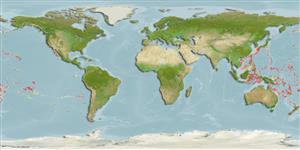>
Eupercaria/misc (Various families in series Eupercaria) >
Labridae (Wrasses) > Bodianinae
Etymology: Bodianus: Bodianus after Bodiano or Pudiano, from the Portuguese pudor, meaning modesty (Jordan & Evermann, 1896); cylindriatus: Name from the masculine Latin noun 'cylinder' for roller and 'atus' for having the nature of, apparently in reference to the narrow body. The subgenus Priobodianus from the Latin prior for earlier or former and Portuguese name 'Bodiano' (derived from Bodianus); referring to the primitive features in the species allocated to this subgenus and the hypothesized early if not initial divergence of this line within the evolution of the genus.
More on author: Tanaka.
Environment: milieu / climate zone / depth range / distribution range
Écologie
marin récifal; profondeur 250 - 510 m (Ref. 58302). Temperate
Western Pacific: Japan. More recently reported from the Chesterfield Islands (Ref. 11897). Reported from the Hawaiian Islands (Ref. 58302).
Taille / Poids / Âge
Maturity: Lm ? range ? - ? cm
Max length : 14.2 cm SL mâle / non sexé; (Ref. 75973)
Description synthétique
Clés d'identification | Morphologie | Morphométrie
Épines dorsales (Total) : 12; Rayons mous dorsaux (Total) : 10. This species has the following characters: D XII, 10; caudal fin rays 10 + 12 + 10; pectoral-fin rays ii, 14-15; lateral line scales 30-31 (rarely 31); scales above lateral line 2-3; scales below lateral line 8½-10½; predorsal scales 25-27; total gill rakers 13-17; upper jaw have prominent anterior canines of similar size; dental ridge is low, 2 consecutive rows of shorter canines, the first with 4 teeth slightly longer than 4-5 in second row; posterior end of upper jaw with moderately large canine; lower jaw with first prominent anterior canine ca ½ - 2/3 size of second, directed anterodorsally and slightly laterally; dental ridge low with 2 series of smaller caniniform teeth laterally, the first with about 4 teeth slightly longer than 6-7 in second; similar sized lateral teeth in both jaws; shallow body, 21.3-25.5% SL; snout, 7.6-10.4% SL; short head, 31.8-34.2% SL; first soft ray of pelvic fin not prolonged as filament, at most reaching just beyond anus (Ref. 75973).
Benthopelagic over hard substrates (Ref. 58302). Oviparous, distinct pairing during breeding (Ref. 205).
Life cycle and mating behavior
Maturité | Reproduction | Frai | Œufs | Fécondité | Larves
Oviparous, distinct pairing during breeding (Ref. 205).
Gomon, M.F., 2006. A revision of the labrid fish genus Bodianus with descriptions of eight new species. Rec. Aust. Mus. Suppl. 30:1-133. (Ref. 75973)
Statut dans la liste rouge de l'IUCN (Ref. 130435: Version 2024-1)
Menace pour l'homme
Harmless
Utilisations par l'homme
Outils
Articles particuliers
Télécharger en XML
Sources Internet
Estimates based on models
Preferred temperature (Ref.
123201): 7.1 - 16.9, mean 11.5 °C (based on 102 cells).
Phylogenetic diversity index (Ref.
82804): PD
50 = 0.5000 [Uniqueness, from 0.5 = low to 2.0 = high].
Bayesian length-weight: a=0.01230 (0.00569 - 0.02662), b=3.05 (2.87 - 3.23), in cm total length, based on LWR estimates for this Genus-body shape (Ref.
93245).
Niveau trophique (Ref.
69278): 3.4 ±0.5 se; based on size and trophs of closest relatives
Résilience (Ref.
120179): Haut, temps minimum de doublement de population inférieur à 15 mois (Preliminary K or Fecundity.).
Fishing Vulnerability (Ref.
59153): Low vulnerability (10 of 100).
